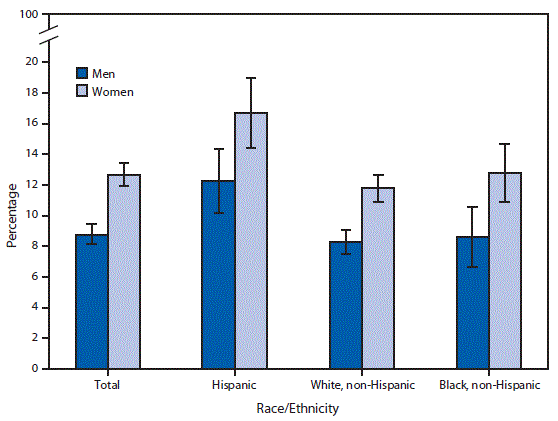QuickStats: Age-Adjusted Percentage* of Adults Aged ≥18 Years Who Reported That They Needed Dental Care During the Past 12 Months But Didn’t Get It Because They Couldn’t Afford It,† by Sex, Race, and Hispanic Origin§ — National Health Interview Survey, 2017¶
Weekly / March 22, 2019 / 68(11);273
Altmetric:

* With 95% confidence intervals indicated with error bars.
† Based on a question that asked respondents “During the past 12 months, was there any time when you needed any of the following but didn’t get it because you couldn’t afford it: Dental care (including check-ups)?” Persons who said they did not know or refused to answer were considered unknown and not included in the analysis.
§ Categories shown are for Hispanic adults, who might be of any race or combination of races, and non‐Hispanic adults who selected one racial group; not all racial groups are shown. Percentages shown for “Total” are based on all adults aged ≥18 years.
¶ Estimates are based on household interviews of a sample of the civilian, noninstitutionalized U.S. population aged ≥18 years and are age-adjusted using the projected 2000 U.S. population as the standard population and four age groups: 18–44, 45–64, 65–74, and ≥75 years.
In 2017, more women (12.7%) than men (8.8%) reported that at some time during the past 12 months they needed dental care but didn’t get it because they couldn’t afford it. This pattern was consistent within each racial/ethnic group: Hispanic, non-Hispanic white, and non-Hispanic black. Among both men and women, Hispanic adults were most likely to have unmet needs for dental care because they couldn’t afford it. Nearly 17% of Hispanic women could not afford to meet their dental care needs, compared with 12.8% of non-Hispanic black women and 11.8% of non-Hispanic white women; 12.3% of Hispanic men had unmet dental care needs, compared with 8.6% of non-Hispanic black men and 8.3% of non-Hispanic white men.
Source: Tables of Summary Health Statistics, 2017. https://ftp.cdc.gov/pub/Health_Statistics/NCHS/NHIS/SHS/2017_SHS_Table_A-19.pdf.
Reported by: Debra L. Blackwell, PhD, DBlackwell@cdc.gov, 301-458-4103; Maria A. Villarroel, PhD.
Suggested citation for this article: QuickStats: Age-Adjusted Percentage of Adults Aged ≥18 Years Who Reported That They Needed Dental Care During the Past 12 Months But Didn’t Get It Because They Couldn’t Afford It, by Sex, Race, and Hispanic Origin — National Health Interview Survey, 2017. MMWR Morb Mortal Wkly Rep 2019;68:273. DOI: http://dx.doi.org/10.15585/mmwr.mm6811a4.
MMWR and Morbidity and Mortality Weekly Report are service marks of the U.S. Department of Health and Human Services.
Use of trade names and commercial sources is for identification only and does not imply endorsement by the U.S. Department of
Health and Human Services.
References to non-CDC sites on the Internet are
provided as a service to MMWR readers and do not constitute or imply
endorsement of these organizations or their programs by CDC or the U.S.
Department of Health and Human Services. CDC is not responsible for the content
of pages found at these sites. URL addresses listed in MMWR were current as of
the date of publication.
All HTML versions of MMWR articles are generated from final proofs through an automated process. This conversion might result in character translation or format errors in the HTML version. Users are referred to the electronic PDF version (https://www.cdc.gov/mmwr) and/or the original MMWR paper copy for printable versions of official text, figures, and tables.
Questions or messages regarding errors in formatting should be addressed to mmwrq@cdc.gov.